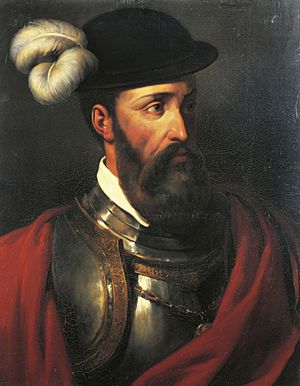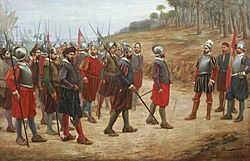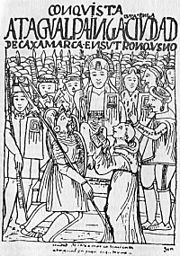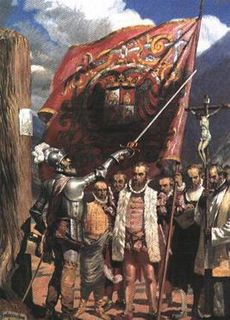Spanish conquest of the Inca Empire facts for kids
Quick facts for kids Spanish conquest of the Inca Empire |
|||||||||
|---|---|---|---|---|---|---|---|---|---|
| Part of the Spanish conquest of the Americas | |||||||||
 Spanish conquest of Peru |
|||||||||
|
|||||||||
| Belligerents | |||||||||
|
|
|||||||||
| Commanders and leaders | |||||||||
|
|||||||||
| Strength | |||||||||
| 168 soldiers (1532) Unknown number of native auxiliaries +3,000 Spanish soldiers and tens of thousands of indigenous allies (1535) |
100,000 soldiers (1532) Tens of thousands of warriors (1535) |
||||||||
| Casualties and losses | |||||||||
| Unknown | Unknown | ||||||||
The Spanish conquest of the Inca Empire, also known as the Conquest of Peru, was one of the most important campaigns in the Spanish colonization of the Americas.
When the Spanish arrived at the borders of the Inca Empire in 1528, it was by far the largest of the four grand pre-Columbian civilizations. Emperor Huayna Capac ruled the empire. He could trace his lineage back to a "stranger king" named Manco Cápac, the mythical founder of the Inca clan.
Huayna Capac relied on his sons to support his reign. While he had many children, two of his sons are historically important. Prince Túpac Cusi Hualpa, also known as Huáscar, was the son of Coya Mama Rahua Occllo of the royal line. The second was Atahualpa, a son who was likely born of a daughter of the last independent King of Quitu. These two sons would play pivotal roles in the final years of the Inca Empire.
The Spanish conquistador Pizarro and his men were greatly aided in their enterprise by invading when the Inca Empire was in the midst of a war of succession between the princes Huáscar and Atahualpa. Atahualpa seems to have spent more time with Huayna Capac during the years when he was in the north with the army conquering Ecuador. Atahualpa was thus closer to and had better relations with the army and its leading generals. When both Huayna Capac and his eldest son and designated heir, Ninan Cuyochic, died suddenly in 1528 from what was probably smallpox, a disease introduced by the Spanish into the Americas, the question of who would succeed as emperor was thrown open. Huayna had died before he could nominate the new heir.
At the time of Huayna Capac's death, Huáscar was in the capital Cuzco, while Atahualpa was in Quito with the main body of the Inca army. Huáscar had himself proclaimed Sapa Inca (i.e. "Only Emperor") in Cuzco, but the army declared loyalty to Atahualpa. The resulting dispute led to the Inca Civil War.
Contents
Chronology of the last years of the Inca Empire
- c. 1528 – Francisco Pizarro and Diego de Almagro make first contact with the Inca Empire at Tumbes, the northernmost Inca stronghold along the coast. The Inca Emperor Huayna Capac dies from European-introduced smallpox. Death sets off a civil war between his sons: Atahualpa and Huáscar
- 1528–1529 – Pizarro returns to Spain where the Queen of Spain grants him the license to conquer Peru
- 1531–1532 – Pizarro's third voyage to Peru. Spaniards form a bond with the Natives (Huancas, Chankas, Cañaris and Chachapoyas) who were under the oppression of the Inca Empire, and Pizarro includes them among his troops to face the Incas. Atahualpa is captured by Spanish.
- 1533 – Almagro arrives; Atahualpa is executed after he orders Huáscar to be killed; Pizarro submits Cuzco and installs seventeen-year-old Manco Inca as new Inca Emperor
- 1535 – Pizarro founds the city of Lima; De Almagro leaves for present-day Chile
- 1536 – Gonzalo Pizarro steals Manco Inca's wife, Cura Olcollo. Manco rebels and surrounds Cuzco. Juan Pizarro is killed, and Inca general Quizo Yupanqui attacks Lima
- 1537 – Almagro seizes Cuzco from Hernando and Gonzalo Pizarro. Rodrigo Orgóñez sacks Vitcos and captures Manco Inca's son, Titu Cusi. Manco escapes and flees to Vilcabamba, which became the capital of the Neo-Inca State
- 1538 – Hernando Pizarro executes Diego de Almagro
- 1539 – Gonzalo Pizarro invades and sacks Vilcabamba; Manco Inca escapes but Francisco Pizarro executes Manco's wife, Cura Olcollo
- 1541 – Francisco Pizarro is murdered by Diego de Almagro II and other supporters of De Almagro
- 1544 – Manco Inca is murdered by supporters of Diego de Almagro. The Inca do not stop their revolt
- 1572 – Viceroy of Peru, Francisco Toledo, declares war on the Neo-Inca State; Vilcabamba is sacked and Túpac Amaru, the last Inca Emperor, is captured and executed in Cuzco. The Neo-Inca capital of Vilcabamba is abandoned; the Spanish remove inhabitants and relocate them to the newly established Christian town of San Francisco de la Victoria de Vilcabamba
Beginning of the conflict
The civil war between Atahualpa and Huascar weakened the empire immediately prior to its struggle with the Spanish. Atahualpa appeared to be more popular with the people than his brother, and he was certainly more valued by the army, the core of which was based in the recently conquered northern province of Quito.
At the outset of the conflict, each brother controlled his respective domains, with Atahualpa secure in the north, and Huáscar controlling the capital of Cuzco and the large territory to the south, including the area around Lake Titicaca. This region had supplied large numbers of soldiers for Huáscar's forces. After a period of diplomatic posturing and jockeying for position, open warfare broke out. Huáscar seemed poised to bring the war to a rapid and decisive conclusion, as troops loyal to him took Atahualpa prisoner, while he was attending a festival in the city of Tumebamba. However, Atahualpa quickly escaped and returned to Quito. There, he was able to amass what is estimated to be at least 30,000 well-trained soldiers. While Huáscar managed to muster about the same number of soldiers, they were much less experienced.
Atahualpa sent his forces south under the command of two of his leading generals, Challcuchima and Quisquis, who won an uninterrupted series of victories against Huáscar that soon brought them to the very gates of Cuzco. On the first day of the battle for Cuzco, the forces loyal to Huáscar gained an early advantage. However, on the second day, Huáscar personally led an ill-advised "surprise" attack, of which the generals Challcuchima and Quisquis had advanced knowledge. In the ensuing battle, Huáscar was captured, and resistance completely collapsed. The victorious generals sent word north by chasqui messenger to Atahualpa, who had moved south from Quito to the royal resort springs outside Cajamarca. The messenger arrived with news of the final victory on the same day that Pizarro and his small band of adventurers, together with some indigenous allies, descended from the Andes into the town of Cajamarca.
Arrival of Pizarro
Francisco Pizarro and his brothers (Gonzalo, Juan, and Hernando) were attracted by the rumors of a rich and fabulous kingdom. In 1529, Francisco Pizarro obtained permission from the Spanish Monarchy to conquer the land they called Peru.
When Pizarro arrived in Peru in 1532, he found it vastly different from when he had been there just five years before. Amid the ruins of the city of Tumbes, he tried to piece together the situation before him. From two local boys, whom Pizarro had taught how to speak Spanish in order to translate for him, Pizarro learned of the civil war and of the disease that was destroying the Inca Empire.
After four long expeditions, Pizarro established the first Spanish settlement in northern Peru, calling it San Miguel de Piura.
When first spotted by the natives, Pizarro and his men were thought to be Viracocha Cuna or "gods". The Natives described Pizarro's men to the Inca. They said that capito was tall with a full beard and was completely wrapped in clothing. Atahualpa was fearful of what the newly arrived white men were capable of. If they were runa quicachac or "destroyers of peoples," then he should flee. If they were Viracocha Cuna Runa allichac or "gods who are benefactors of the people," then he should not flee, but welcome them. The messengers went back to Tangarala, and Atahualpa sent Cinquinchara, an Orejon warrior, to the Spanish to serve as an interpreter.
After traveling with the Spanish, Cinquinchara returned to Atahualpa; they discussed whether or not the Spanish men were gods. Cinquinchara decided they were men because he saw them eat, drink, and dress. He saw them produce no miracles. Cinquinchara informed Atahualpa that they were small in number, about 170–180 men. When Atahualpa asked what to do about the strangers, Cinquinchara advised that they be killed.
Capture of Atahualpa
After his victory and the capture of his brother Huáscar, Atahualpa was fasting in the Inca baths outside Cajamarca. Pizarro and his men reached the city on 15 November 1532.
Pizarro sent Hernando de Soto to the Atahualpa's camp. Soto rode to meet Atahualpa on his horse, an animal that Atahualpa had never seen before. With one of his young interpreters, Soto read a prepared speech to Atahualpa telling him that they had come as servants of God to teach them the truth about God's word. Additionally, they invited the Inca leader to visit Pizarro at his quarters along the Cajamarca plaza. When De Soto noticed Atahualpa's interest in his horse, he put on a display of "excellent horsemanship" in close proximity. Atahualpa displayed hospitality by serving refreshments.
Atahualpa responded only after Francisco Pizarro's brother, Hernando Pizarro, arrived. He replied with what he had heard from his scouts, that that the Spanish had been killing and enslaving countless numbers of people and civilians on the coast. Pizarro denied the report and Atahualpa, with limited information, reluctantly let the matter go. At the end of their meeting, the men agreed to meet the next day at Cajamarca.
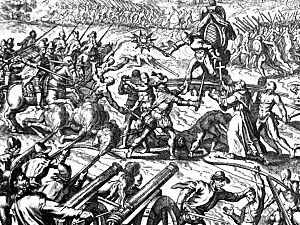
The next morning, on 16 November 1532, Pizarro had arranged an ambuscade around the Cajamarca plaza, where they were to meet. At this point, Pizarro had in total 168 men under his command: 106 on foot and 62 on horseback. When Atahualpa arrived with about 6,000 unarmed followers, Friar Vincente de Valverde and the interpreter Felipillo met them and proceeded to "expound the doctrines of the true faith" (requerimiento) and seek his tribute as a vassal of King Charles. The unskilled translator likely contributed to problems in communication. The friar offered Atahualpa the Bible as the authority of what he had just stated. Atahualpa stated, "I will be no man's tributary."
Pizarro urged attack, starting the Battle of Cajamarca. The battle began with a shot from a cannon and the battle cry "Santiago!" The Spaniards unleashed volleys of gunfire at the vulnerable mass of Incas and surged forward in a concerted action. Pizarro also used devastating cavalry charges against the Inca forces, which stunned them in combination with the supporting gunfire. However, many of the guns used by the Spaniards were hard to use in close-quarters combat. The effect was devastating, and the shocked Incas offered such feeble resistance that the battle has often been labeled a massacre, with the 2,000 Incas slain and the Spanish with only one soldier wounded.
Pizarro knew that his forces were badly outnumbered but that capturing the Emperor and holding him hostage would give him a key edge.
After the Spanish captured Atahualpa at the massacre at Cajamarca, they allowed his wives to join him, and the Spanish soldiers taught him the game of chess. During Atahualpa's captivity, the Spanish, although greatly outnumbered, forced him to order his generals to back down by threatening to kill him if he did not. According to the Spanish envoy's demands, Atahualpa offered to fill a large room with gold and promised twice that amount in silver. While Pizarro ostensibly accepted this offer and allowed the gold to pile up, he had no intention of releasing the Inca. He needed Atahualpa's influence over his generals and the people in order to maintain the peace. The treasure began to be delivered from Cuzco on 20 December 1532 and flowed steadily from then on. By 3 May 1533 Pizarro received all the treasure he had requested; it was melted, refined, and made into bars. Hernando Pizarro went to gather gold and silver from the temples in Pachacamac in January 1533, and on his return in March, captured Chalcuchimac in the Jauja Valley. Francisco Pizzaro sent a similar expedition to Cuzco, bringing back many gold plates from the Temple of the Sun.
The question eventually came up of what to do with Atahualpa; both Pizarro and Soto reportedly spoke against killing him, but the other Spaniards disagreed. False interpretations from the interpreter Felipillo made the Spaniards paranoid. They were told that Atahualpa had ordered secret attacks and his warriors were hidden in the surrounding area. Soto went with a small force to scout for the hidden army, and the show trial of Atahualpa was held in his absence. Among the charges were polygamy and idolatry, all frowned upon in Catholicism but common in Inca culture and religion.
The men who were against Atahualpa's conviction argued that he should be judged by King Charles since he was the sovereign prince. Atahualpa was forced to submit to baptism to avoid being burned at the stake and in the hopes of one day rejoining his army and killing the Spanish; they referred to him as Francisco for the purposes of the ritual. On 29 August 1533 the Spanish murdered Atahualpa. He was buried with Christian rites in the church of San Francisco at Cajamarca, but was soon disinterred. His body was recovered, probably at his prior request, and borne to its final resting place in Quito. Upon de Soto's return, he was furious; he had found no evidence of any secret gathering of Atahualpa's warriors.
Pizarro advanced with his army of 500 Spaniards toward Cuzco, accompanied by Chalcuchimac. Manco Inca Yupanqui joined Pizarro after the death of Túpac Huallpa. Pizarro's force entered the heart of the Tawantinsuyu on 15 November 1533.
Rebellion and reconquest
After Atahualpa's murder, Pizarro installed Atahualpa's brother, Túpac Huallpa, as a puppet Inca ruler, but he soon died unexpectedly, leaving Manco Inca Yupanqui in power. He began his rule as an ally of the Spanish. However, in 1535 he was left in Cuzco under the control of Pizarro's brothers, Juan and Gonzalo, who so mistreated Manco Inca that he ultimately rebelled. Under the pretense of recovering a statue of pure gold in the nearby Yucay valley, Manco was able to escape Cuzco.
Manco Inca hoped to recapture Cuzco starting in April 1536. The siege of Cuzco was waged until the following spring, and during that time Manco's armies managed to wipe out four relief columns sent from Lima, but was ultimately unsuccessful in its goal of routing the Spaniards from the city. The Inca leadership did not have the full support of all its subject peoples and furthermore, the degrading state of Inca morale coupled with the superior Spanish siege weapons soon made Manco Inca realize his hope of recapturing Cuzco was failing. Manco Inca retreated to the mountainous region of Vilcabamba and established the small Neo-Inca State, where Manco Inca and his successors continued to hold some power for several more decades. His son, Túpac Amaru, was the last Inca, killed by the Spanish in 1572.
In total, the conquest took about forty years to complete. Many Inca attempts to regain their empire had occurred, but none had been successful. Thus the Spanish conquest was achieved, aided by factors like smallpox. The Spaniards destroyed much of the Incan culture and imposed Spanish culture onto the native population.
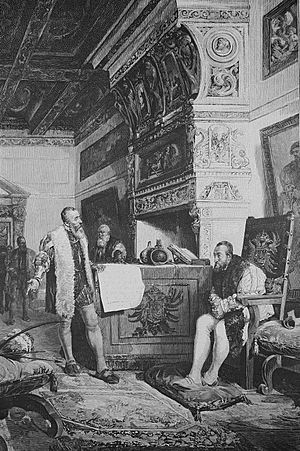
Aftermath
The integration of Spanish culture into Peru was carried out not only by Pizarro and his other captains, but also by the many Spanish who also came to Peru to exploit its riches and inhabit its land. These included many different kinds of immigrants such as Spanish merchants, peasants, artisans, and Spanish women. Another element that the Spanish brought with them were African slaves to work alongside captive Incas for use in labor with things such as agriculture and mining for silver.
Effects of the conquest on the people of Peru
The Incan population suffered a dramatic and rapid decline. The population decline for the Inca Empire from 1520 to 1571 is roughly estimated at from 10 to 12 million in 1520 to less than 3 million in 1570 with the population still declining after 1570.
The single greatest cause of the decimation of native populations was Old World infectious diseases, carried by colonists and conquistadors. As these were new to the natives, they had no acquired immunity and suffered very high rates of death. More died of disease than any army or armed conflict. As the Inca did not have as strong a writing tradition as the Aztec or Maya, it is difficult for historians to estimate population decline or any events after conquest. But, it is sometimes argued, and equally disputed among scholars that the Inca began to contract these diseases several years before the Spanish appeared in the region, as it was possibly carried to their empire by traders and travelers.
Beyond the devastation of the local populations by disease, they suffered considerable enslavement, pillaging and destruction from warfare. The basic policy of the Spanish towards local populations was that voluntary vassalage would yield safety and coexistence, while continued resistance would result in more deaths and destruction.
Another significant effect on the people in South America was the spread of Christianity. As Pizarro and the Spanish subdued the continent and brought it under their control, they forcefully converted many to Christianity. It took just a generation for the entire continent to be under Christian influence.
Environmental impact
Recent research points out that Spanish conquest of the Inca altered Peru's shoreline. Before the Spaniards arrived, inhabitants of the arid northern Peruvian coast clad massive sand dune–like ridges with a -likely- accidental form of "armor", millions of discarded mollusk shells, which protected the ridges from erosion for nearly 4700 years prior to the Spanish arrival, and produced a vast corrugated landscape that is visible from space. This incidental landscape protection came to a swift end, however, after diseases brought by Spanish colonists decimated the local population and after colonial officials resettled the survivors inland, without humans to create the protective covering, newly formed beach ridges simply eroded and vanished.
In fiction
Marmontel's novel Les Incas, ou la destruction de l'empire du Perou (1777), inspired by Bartolomé de Las Casas's Account, tells a fictitious version of the conquest of Peru to portray the author's views on the religious fanaticism of the Conquistadors and their cruelty to the natives.
An opera of Verdi, Alzira (1845), is set during the Conquest. In the play, an Inca called Zamoro wants to find the princess Alzira, who has been engaged to the Conquistador Gusmano.
The second act of Rameau's Les Indes galantes (1735) is called Les incas du Pérou and tells the love story of a Spanish Conquistador and an Inca princess.
The Spanish Comedy La aurora en Copacabana, written by Pedro Calderón de la Barca, dramatizes the Conquest under a religious perspective, adding allegorical characters that represents the Idolatry and the Christian conversion of the Native Peruvians.
The first part of Madame de Graffigny's epistolary novel Lettres d'une Péruvienne narrates the abduction of Zilia, an Inca princess, by the Spaniards during the Conquest.
Peter Shaffer's play The Royal Hunt of the Sun (1964) dramatizes the conquest of the Incas. In the play, Pizarro, Atahualpa, Valverde and other historical figures appear as characters.
This event is also narrated as a Science Fiction novelette in Randall Garrett's Despoilers of the Golden Empire (1959).
The Ransom Room it's the setting of the romance Das Gold von Caxamalca (1928) by the German novelist Jakob Wasserman.
The conquest is also used as a starting point for the Matthew Reilly novel Temple, where the siege of Cusco is used. Many historical figures are mentioned, especially Pizarro who is mentioned as the pursuer of the protagonist.
The Inca are featured in the third Campaign in Age of Empires 3, having a Lost City hidden in the Andes. They are also in the Multiplayer, found primarily in the areas making up Chile and Argentina. In the Definitive Edition of the game they are a playable faction.
The conquest is parodied in The Simpsons TV series, in the episode "Lost Verizon", written by John Frink.
Pizarro and his fellow conquistadors feature as antagonists in the 1982 animated serial The Mysterious Cities of Gold.
See also
 In Spanish: Conquista del Imperio incaico para niños
In Spanish: Conquista del Imperio incaico para niños
- Ancient Peru
- Encomiendas in Peru
- Habsburg Spain
- History of Peru
- Inca society
- Indian reductions in the Andes
- Paititi
- Pambokancha, an Inca religious site
- Reductions
- Spanish conquest of the Aztec Empire
- Spanish conquest of the Maya
- Spanish conquest of the Muisca
- Spanish conquest of Yucatán



